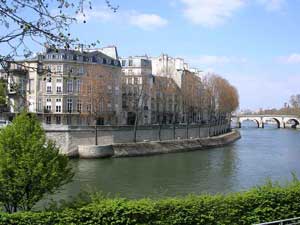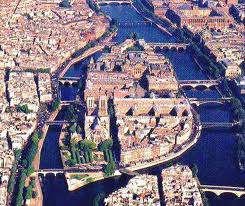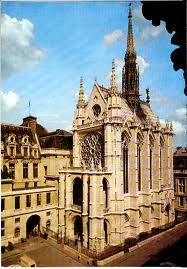It doesn't get any more central or ancient in Paris than the two islands right at the heart of the city.
Bonded to the mainland by bridges; Ile de la Cité and Ile St-Louis have been the heart of the center of Parisian life since the very founding of the city in 300BC.
While Julius Caesar was struggling through the last phase of the Gallic Wars, a small tribe called the Parisii made their settlement on the island.
In the 16th century Ile de la Cité got promoted to being the seat of the French monarchy when Clovis crowned himself King of the Franks and it remained a hotbed of French political power until Charles V abandoned it in favor of the Louvre in the 14th century.
After being forsaken by royalty, Ile de la Cité could have sunk into obscurity as Paris grew around it but the stunning Notre Dame, as well as the Sainte-Chapelle and La Conciergerie, have ensured that the island remains a center of Parisian religious, political, and cultural life. Not to mention the tourists love it.

Ile St-Louis is the less glamorous but charming-in-other-ways twin of Ile de la Cité.
It was once two islands, Ile Notre-Dame and Ile aux Vaches, and considered fit for nothing more than grazing cows (hence the name). In 1267, the area was renamed in honor of Louis IX after he departed for the Crusades. The 17th century saw the two islands merge under the direction of architect Louis Le Vau, and Île St-Louis was transformed from worthless grazing ground into chic residential district.
Builders had a field day on the island and created some of the most beautiful mansions in Paris. Baroque architect Louis Le Vau (who later worked on Versailles) was commissioned to design incredible private homes for the wealthy, including the majestic mansions, the Hôtel Lambert and the Hôtel de Lauzun on the lovely quai d'Anjou.
Distinguished residents of the island have included Voltaire, Mme. de Châtelet, Baudelaire, Balzac, Delacroix, and Cézanne.
While Ile de la Cité is crawling with tourists (and rightly so because the place is like a floating museum), when you walk over Pont St-Louis onto the sister island you feel like you have stumbled into a village, albeit a very well-heeled, well-preserved village.
The main attraction is the church St-Louis-en-L'Ile. The streets around it are crowded with nice restaurants, fancy and indie art galleries, small hotels and a variety of boutiques that sell anything from award winning cheese to costly silk scarves. Wandering around Ile St-Louis feels like taking a holiday from the big, noisy city.

The older, bigger, flashier sibling, Ile de la Cité is the perfect place to start any visit to Paris.
Like in many other countries, in France distances are measured from KM 0 -kilomètre zéro- and it is marked by a circular sundial in a square in front of Notre Dame cathedral, where better to start to discover the city than that? On the western peak of Ile de la Cité you can find one of Paris's oldest squares, the august Place Dauphine while Sainte-Chapelle, the marvelous medieval chapel built by King Louis IX is just a few minutes walk away.
The Conciergerie, the prison where Marie-Antoinette and other royals and nobles awaited their turn at the guillotine during the Revolution offers you a glimpse into Paris' darker side.
Some of the sights to see on Ile de la Cité are world-famous but don't get blinded by the celebrity of the attractions and forget to look further afield. Notre Dame is one of Paris's most visited sights and it should be high up on your list of things to do, but it also shares this small island with other monuments of historical and architectural importance.
The tangled labyrinth of medieval streets give you an illuminating insight into the humble beginnings of this enchanting city while the Conciergerie and the Memorial de la Déportation are testament to some of Paris's most obscure hours.
Ile Saint-Louis does not have the big names to draw in the tourists, but will instead lull you with its quiet, understated yet equally enchanting charm.
Notre Dame
Notre Dame may not be France's oldest or largest cathedral but in beauty and architectural harmony it has few peers. And it's not just a pretty face either: Notre Dame can host over 10,000 parishioners. It was one of the first Gothic cathedrals in Europe and it is a master class in the gothic and dramatic. Victor Hugo obviously realized its importance when he used it as the location for his immensely popular novel Notre-Dame de Paris. As well as making Hugo a very rich man, the publication of the novel in 1831 brought the cathedral's state of disrepair to the attention of the public and spurred on renovations. For more information, check out Notre Dame in the attractions section of our Paris guide.

Sainte-Chapelle
If you are lucky enough to be blessed with a sunny day during your trip to Paris, this should be the first place on your list to visit. Just wait for the light to be filtered by the stained-glass windows and you will never forget it. The chapel was constructed in 1241 to house King Louis IX's religious relics - which are still visible to this day.
Ancien Cloître Quartier
At the foot of Notre Dame is this often-overlooked web of medieval streets. In the Middle Ages this was the domain of the seminary students one of whom was the famed Peter Abélard. While boarding with Notre Dame's clergyman, Abélard met and fell in love with the clergyman's 17 year old niece Héloïse. Héloïse was seduced by Abélard who was 39 years her senior and got her pregnant. The furious clergyman had Abélard castrated but he survived and fled to a monastery where he spent the rest of his days writing poetic, passionate love letters to Héloïse. Even if the story of the area doesn't interest you, the Ancien Cloître Quartier is quaint and charming.
La Conciergerie
Isn't it ironic that this stunning building that was once part of the original palace of the kings of France was turned into a prison in which lots of them spent their final hours? A visit to the La Conciergerie appeals to anyone who enjoys architecture, history or just a good story. Built by Philip IV in the 13th and 14th centuries, after the royals moved into the Louvre, in 1358 the palace was turned into a prison. During the French Revolution, La Conciergerie was Queen Marie Antoinette's famous last residence as she awaited her fatal trip to the guillotine. A visit is spine-tingling and fascinating all in one go.